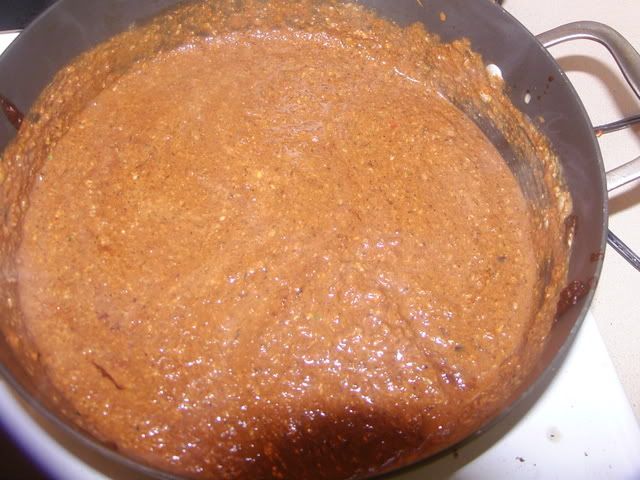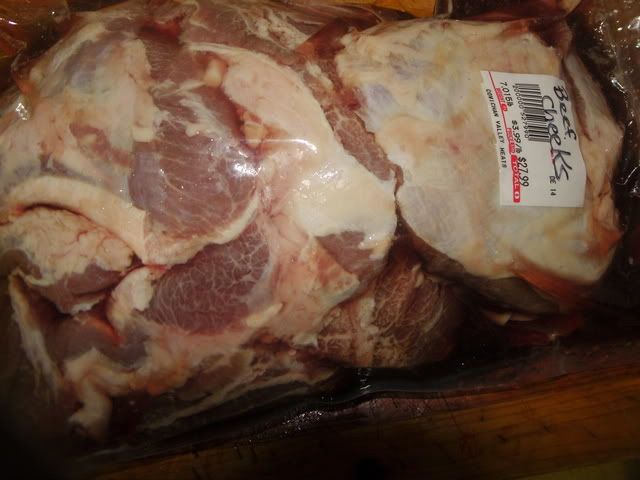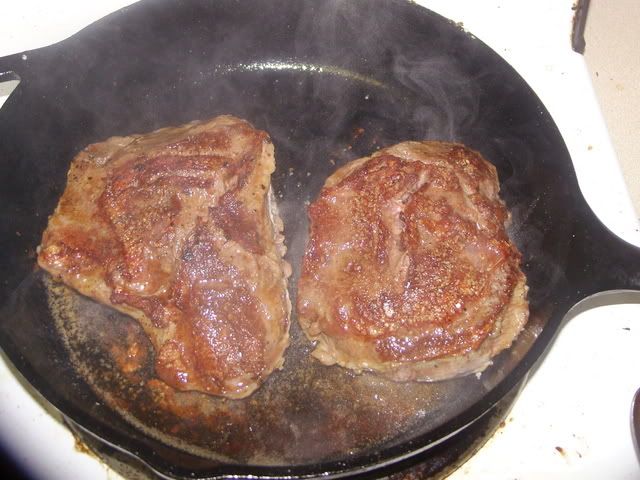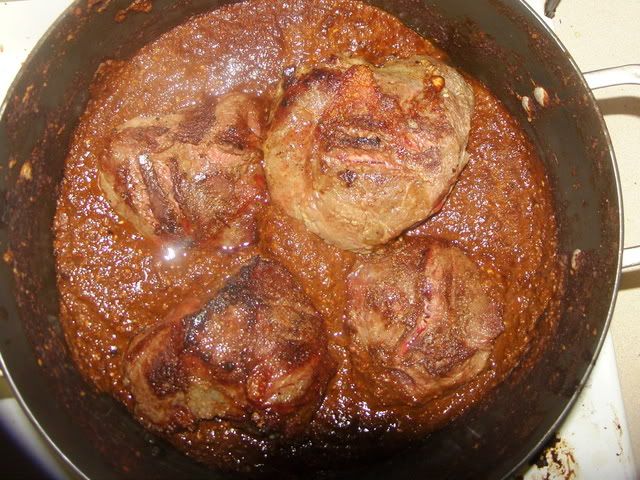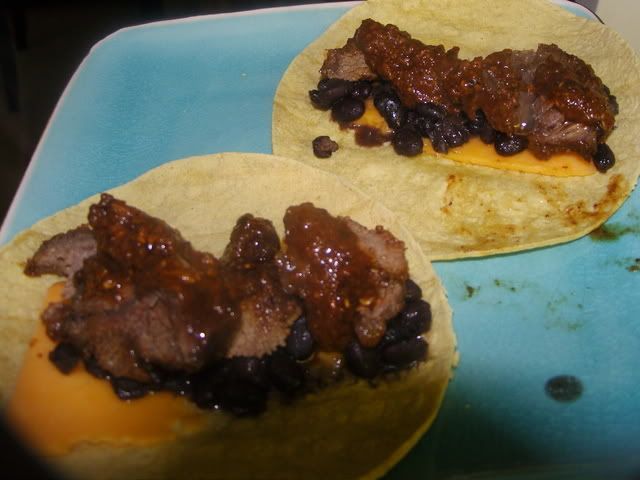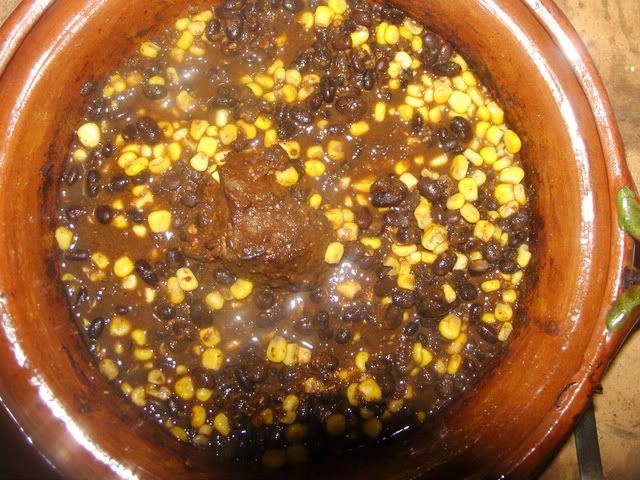K Kruger
TVWBB 1-Star Olympian
Enchiladas are typically made with meat or fowl stewed in water with spices and aromatics. The resulting stock is used in making the sauce and the meat is shredded for filling tortillas. However, enchiladas are great with smoked or roasted meats or fowl and perfect for leftovers. You can use prepared canned or bottled sauces, alone or ‘doctored’, or you can make your own. Enchilada sauces generally come in red or green, the reds based on dried chilies with tomatoes often, but not always, added. Often fresh or roasted green chilies (or salsa) are included as well. Green sauces are tomatillo and green chili based.
Moles are prepared similarly, though sometimes roasted meat or meat browned in lard is used instead of stewed. The meat is served in the sauce; the tortillas are served on the side. They are fairly involved but fun to make (I think so anyway). A mole sauce can be used to reheat leftover smoked meats or fowl very effectively (and deliciously). If you prefer, you can use a mole sauce for making enchiladas. Mole sauces are similarly varied though much more complex and deeply flavored, and also based on dried chilies with tomatoes, onions, and garlic, and additionally flavored and thickened with one or more of sesame seeds, almonds, peanuts, pecans, pumpkin seeds, toasted bread and tortillas; spices often include cinnamon, clove, allspice, peppercorns, avocado or bay leaf, and cumin; chocolate is often used for added depth, and sweeteners include raisins, sugar, and plantain or banana. Mole pastes are available in lieu of making a sauce yourself. You mix the paste with broth or water on the stove. Pastes benefit from additions. The recipes below will give you some ideas on what you might use to doctor a reconstituted paste if you choose to go that route.
In another thread on making enchiladas I posted the methods I use for assembling them, but there are many ways that work. If you’re interested, it’s here.
Enchilada sauces:
#1 Red
1 small dried New Mexico or Ancho pepper, or 1-2 Tbls pure chili powder
2 medium tomatoes, or use 1 can diced in juice
1 large onion, chopped
2 cloves garlic, chopped
6 green New Mexican, Anaheim, or Cuban chilies, or 2 (4 oz.) cans of roasted chilies
1/2 tsp ground cumin
beef or chicken stock or water
1-2 Tbls vegetable oil
pinch sugar
1/4 c crema, crème fraîche, or sour cream (optional)
If using the dried pepper, remove the stem, split the pepper and remove the seeds; toast in a small dry skillet till very fragrant, tossing at times, 1-2 min. Bring enough stock or water to cover the pepper to a boil. Remove the pepper to a bowl, cover with boiling stock or water and allow to soften, about 1 hour. Taste the liquid in the bowl. If bitter, drain the peppers and discard the liquid, if not drain and reserve the liquid.
Meanwhile, roast the tomatoes and chilies on a baking sheet under a broiler (about 4-5 inches below the heat) till blackened in spots; flip and roast the other sides. Sauté the onion in a medium sauté pan over med-high heat till soft, about 7 min; add the garlic and cook 2-3 min more. Remove the tomato cores; peel the tomatoes and peppers.
In batches, purée the tomatoes with the onion and garlic, the re-hydrated pepper, the roasted chilies, and the cumin, adding a little reserved pepper water, plain water, or stock, if needed to facilitate blending. Strain through a medium sieve, if desired, to remove extraneous seeds or skin pieces. Heat a Tbls or two of oil in a sauté pan or pot. Add the sauce and bring to a simmer over medium heat and cook to blend flavors, about 15 min. Adjust salt, taste, and add a pinch of sugar if needed. Add a little reserved (or new) stock if the sauce is too thick, reduce further if too thin. Off heat, whisk in the crema (or other option) if using.
#2 Red
8 dried chilies (a mix of New Mexicos, Pasillas, Anchos, Guajillos—whatever you wish)
2 c chicken stock
2-3 Tbls fresh cilantro leaves, chopped
3 garlic cloves
1 Tbls oregano
1 Tbls cumin
1 Tbls apple cider vinegar
1 large tomato, chopped
pinch salt
1-2 Tbls vegetable oil
pinch freshly ground black pepper
pinch sugar
For each dried pepper, remove the stem, split the pepper and remove the seeds; toast together in a large dry skillet till very fragrant, tossing at times, 1-2 min. Bring the stock to a boil. Remove the peppers to a bowl, cover with boiling stock and allow to soften, about 1 hour. Taste the liquid in the bowl. If bitter, drain the peppers and discard the liquid, if not drain and reserve the liquid.
In a blender, place the chilies and reserved stock (or use fresh if needed). Blend until chopped. Strain out the larger pieces of skin or seeds, if desired, with a sieve. Return to the blender and add the cilantro, garlic, oregano, cumin, vinegar, tomato, and salt and pepper. (Purée in batches if necessary.) Blend until very smooth.
Over a medium heat, in a heavy skillet, heat the oil. Pour the sauce into the oil and cook for about 15 minutes until the flavors blend. Taste and adjust salt, pepper, and sugar.
#3 Red w/o tomato—can be used as is, or as a base to build from
2 Tbls lard or oil shortening
2 Tbls flour
2 Tbls chile powder (Ancho, New Mexico, a blend; whatever)
1 tsp ground cumin
1 tsp garlic powder
2 c water or chicken stock
Salt
Heat the lard or oil in a sauté pan till very hot. Slowly whisk in the flour and cook, whisking constantly, till the flour has lost its raw look and takes on a slightly nutty flavor, about 4-5 min. Add the spices then slowly whisk in the water or stock. Cook 3-4 min; add salt to taste.
Green
1 lb tomatillos, husked and washed
3-5 serrano or jalapeño peppers, seeded and ribbed, if desired
chicken stock
2 small cloves garlic
3 Tbls chopped onion
1 Tbls minced cilantro leaves, optional
Salt to taste
Place the tomatillos and peppers in a small pot with water to cover. Bring to a boil over high heat and cook till the tomatillos have darkened, about 7 min. Drain. Place in a blender with the garlic and onion; pour in enough stock to cover; purée, adding a bit more stock during blending. Pour back into the small pot and return to a simmer over med heat, for about 3-5 min. Stir in optional cilantro; add salt to taste.
Alternatively: Roast the tomatillos and peppers in an open flame or under a broiler till blackened in spots, turning as needed. Peel, if desired (I usually don’t), then place in a blender continuing with the recipe from there.
Mole (there are a million possibilities—this is the last one I made)
Though you can do this without pepitas, try to find them. They’re available at most Hispanic markets, often the Mexican spice section of supermarkets, Trader Joes’s, and most health food stores. Pecans make a good substitution for one of the nuts, if necessary. Though some cooks fry everything in lard, I toast the dry items in a dry pan and fry the moist items in a little oil. This avoids the somewhat greasy, heavier consistency of strictly-lard moles. The effort here is to create a complex, multi-layered flavor, with no single item predominant. A splash of vinegar can be used at the end to intensify the flavor—be sparing if you choose to use it. Additionally, while naturally sweet items like ripe plantain, raisins and a sugar are called for in the recipe to balance the dry acidity of the peppers, be careful with the sugar. In my opinion, moles are best when not too sweet. Shoot for a balance: Taste as you go.
16 whole dried peppers (I used a mix of Chiles Negros, New Mexicos, Anchos, and Guajillos), washed in cool water and dried well
2-3 Chiles de Arbol, washed in cool water, dried well
3 med-large tomatoes
6 c chicken stock
2 small onions, chopped
8 cloves garlic, coarsely chopped
1/2 c sesame seeds
1/2 c slivered almonds
1/2 c peanuts, chopped
1/2 c pine nuts
1/2 c pepitas (hulled, raw pumpkin seeds)
1 corn tortilla, torn into 4 or 5 pieces
2 slices white bread (I used slices from an Italian artisan loaf; 4-5 slices from a baguette work well)
2 ripe plantains (plantains are only ripe when their yellow skins are at least half blackened, if green or all yellow they are not yet ripe) or use ripe bananas, sliced in 1” pieces
1/4 c currants (or use black raisins)
1 large avocado leaf (or substitute 3 bay leaves—different flavor but still very good)
lard or oil (I used e.v. olive oil for this mole)
½1/2 stick Mexican cinnamon (canela), or 2 tsp powder
5 cloves
1 tsp cumin seed or powder
1 1/2 tsp Mexican oregano
about 2 Tbls piloncillo (or use light or dark Muskovado or brown sugar)
about 3 Tbls unsweetened cocoa (normally I use Mexican chocolate—Ibarra or Abuelito, chopped—but I was out. Or use unsweetened baker’s chocolate.)
salt
vinegar (optional)
Remove and discard the stems from the chilies, split them with your fingers, and discard the seeds that fall out by themselves (optional, you can keep all the seeds if you wish). Toast them in a single layer (in batches if necessary) in a large sauté pan over med-high heat, till toasted and fragrant, 2-3 min, tossing periodically. Remove them to a bowl, cover with boiling water, and allow to re-hydrate, about an hour. (It can be helpful to lay a loose piece of plastic wrap directly on the peppers and place a bowl, plate, or other weight on top.)
Set another sauté pan over med-high heat and add a little oil to the pan. Fry the tomatoes whole, till the skins blacken a bit, rolling them around periodically; cut them in a few pieces each; transfer to a blender. Add a little more oil to the pan; sauté the onions, stirring occasionally, till lightly browned, about 12-15 min. Add the garlic; cook 3 min more, stirring occasionally. Remove to a bowl, not the blender; return the pan to the heat. Meanwhile, in the same pan that you used for the chilies, still dry and on med-high heat, toast the sesame seeds, stirring nearly constantly, till the seeds are lightly browned and fragrant, about 5 min, depending on their moisture and oil content; remove to the blender with the tomatoes.
In the dry pan toast the nuts and seeds in succession till lightly browned and fragrant, about 5 min each (this depends on which you’re doing); stirring frequently to prevent burning. Remove each to the bowl with the onions.
Meanwhile, add a little oil to the pan you used for the tomatoes and fry the plantain slices, stirring occasionally, till just starting to brown in spots, 6-7 min; add a little more oil and the raisins and cook till the raisins plump up a bit, a few min more. Remove to the bowl with the onions. Without adding more oil, toast the bread slices and tortilla pieces till lightly browned and fragrant, turning occasionally; remove to the bowl with the onions.
In the dry pan, meanwhile, toast the avocado leaf (or bay leaves) till fragrant, about 2 min; remove to the bowl with the onions. In this same pan, toast the cinnamon, cumin, cloves, and oregano, till fragrant, about 30-45 secs. Remove to the bowl with the onions.
Set a large pot on the stove. Drain the re-hydrated peppers and place some of them in the blender with the tomatoes and sesame seeds. Pour in a little of the chicken stock and turn on the blender; purée, stopping the blender periodically to push any solids down toward the blades, till blended very well. Pour into the pot through a medium sieve to remove any extraneous skin or seeds. Purée the rest of the peppers well, adding stock as necessary; strain into the pot. Rinse the blender briefly. Purée the contents of the onion bowl in batches, adding stock as needed to facilitate blending (you should end up using all the stock), blending very well till smooth; pour into the pot without straining. Place the pot over med-high heat and bring just to a low boil. Add the sugar and chocolate, stirring well till completely melted or dissolved. Add a little salt.
Reduce the heat and simmer, stirring occasionally, till the flavors blend and the sauce is the consistency of heavy cream. Adjust the salt; adjust the balance with sugar and/or vinegar. You’re done.
The sauce can be used as is, or you can thin some of it with stock for use as an enchilada sauce, or as a sauce to pour over cooked meats. I often use it a bit thinned and add leftover Q’d meats for reheating. When the meat is hot I remove it, then reduce the sauce over high heat till it’s thickened a bit.
Moles are prepared similarly, though sometimes roasted meat or meat browned in lard is used instead of stewed. The meat is served in the sauce; the tortillas are served on the side. They are fairly involved but fun to make (I think so anyway). A mole sauce can be used to reheat leftover smoked meats or fowl very effectively (and deliciously). If you prefer, you can use a mole sauce for making enchiladas. Mole sauces are similarly varied though much more complex and deeply flavored, and also based on dried chilies with tomatoes, onions, and garlic, and additionally flavored and thickened with one or more of sesame seeds, almonds, peanuts, pecans, pumpkin seeds, toasted bread and tortillas; spices often include cinnamon, clove, allspice, peppercorns, avocado or bay leaf, and cumin; chocolate is often used for added depth, and sweeteners include raisins, sugar, and plantain or banana. Mole pastes are available in lieu of making a sauce yourself. You mix the paste with broth or water on the stove. Pastes benefit from additions. The recipes below will give you some ideas on what you might use to doctor a reconstituted paste if you choose to go that route.
In another thread on making enchiladas I posted the methods I use for assembling them, but there are many ways that work. If you’re interested, it’s here.
Enchilada sauces:
#1 Red
1 small dried New Mexico or Ancho pepper, or 1-2 Tbls pure chili powder
2 medium tomatoes, or use 1 can diced in juice
1 large onion, chopped
2 cloves garlic, chopped
6 green New Mexican, Anaheim, or Cuban chilies, or 2 (4 oz.) cans of roasted chilies
1/2 tsp ground cumin
beef or chicken stock or water
1-2 Tbls vegetable oil
pinch sugar
1/4 c crema, crème fraîche, or sour cream (optional)
If using the dried pepper, remove the stem, split the pepper and remove the seeds; toast in a small dry skillet till very fragrant, tossing at times, 1-2 min. Bring enough stock or water to cover the pepper to a boil. Remove the pepper to a bowl, cover with boiling stock or water and allow to soften, about 1 hour. Taste the liquid in the bowl. If bitter, drain the peppers and discard the liquid, if not drain and reserve the liquid.
Meanwhile, roast the tomatoes and chilies on a baking sheet under a broiler (about 4-5 inches below the heat) till blackened in spots; flip and roast the other sides. Sauté the onion in a medium sauté pan over med-high heat till soft, about 7 min; add the garlic and cook 2-3 min more. Remove the tomato cores; peel the tomatoes and peppers.
In batches, purée the tomatoes with the onion and garlic, the re-hydrated pepper, the roasted chilies, and the cumin, adding a little reserved pepper water, plain water, or stock, if needed to facilitate blending. Strain through a medium sieve, if desired, to remove extraneous seeds or skin pieces. Heat a Tbls or two of oil in a sauté pan or pot. Add the sauce and bring to a simmer over medium heat and cook to blend flavors, about 15 min. Adjust salt, taste, and add a pinch of sugar if needed. Add a little reserved (or new) stock if the sauce is too thick, reduce further if too thin. Off heat, whisk in the crema (or other option) if using.
#2 Red
8 dried chilies (a mix of New Mexicos, Pasillas, Anchos, Guajillos—whatever you wish)
2 c chicken stock
2-3 Tbls fresh cilantro leaves, chopped
3 garlic cloves
1 Tbls oregano
1 Tbls cumin
1 Tbls apple cider vinegar
1 large tomato, chopped
pinch salt
1-2 Tbls vegetable oil
pinch freshly ground black pepper
pinch sugar
For each dried pepper, remove the stem, split the pepper and remove the seeds; toast together in a large dry skillet till very fragrant, tossing at times, 1-2 min. Bring the stock to a boil. Remove the peppers to a bowl, cover with boiling stock and allow to soften, about 1 hour. Taste the liquid in the bowl. If bitter, drain the peppers and discard the liquid, if not drain and reserve the liquid.
In a blender, place the chilies and reserved stock (or use fresh if needed). Blend until chopped. Strain out the larger pieces of skin or seeds, if desired, with a sieve. Return to the blender and add the cilantro, garlic, oregano, cumin, vinegar, tomato, and salt and pepper. (Purée in batches if necessary.) Blend until very smooth.
Over a medium heat, in a heavy skillet, heat the oil. Pour the sauce into the oil and cook for about 15 minutes until the flavors blend. Taste and adjust salt, pepper, and sugar.
#3 Red w/o tomato—can be used as is, or as a base to build from
2 Tbls lard or oil shortening
2 Tbls flour
2 Tbls chile powder (Ancho, New Mexico, a blend; whatever)
1 tsp ground cumin
1 tsp garlic powder
2 c water or chicken stock
Salt
Heat the lard or oil in a sauté pan till very hot. Slowly whisk in the flour and cook, whisking constantly, till the flour has lost its raw look and takes on a slightly nutty flavor, about 4-5 min. Add the spices then slowly whisk in the water or stock. Cook 3-4 min; add salt to taste.
Green
1 lb tomatillos, husked and washed
3-5 serrano or jalapeño peppers, seeded and ribbed, if desired
chicken stock
2 small cloves garlic
3 Tbls chopped onion
1 Tbls minced cilantro leaves, optional
Salt to taste
Place the tomatillos and peppers in a small pot with water to cover. Bring to a boil over high heat and cook till the tomatillos have darkened, about 7 min. Drain. Place in a blender with the garlic and onion; pour in enough stock to cover; purée, adding a bit more stock during blending. Pour back into the small pot and return to a simmer over med heat, for about 3-5 min. Stir in optional cilantro; add salt to taste.
Alternatively: Roast the tomatillos and peppers in an open flame or under a broiler till blackened in spots, turning as needed. Peel, if desired (I usually don’t), then place in a blender continuing with the recipe from there.
Mole (there are a million possibilities—this is the last one I made)
Though you can do this without pepitas, try to find them. They’re available at most Hispanic markets, often the Mexican spice section of supermarkets, Trader Joes’s, and most health food stores. Pecans make a good substitution for one of the nuts, if necessary. Though some cooks fry everything in lard, I toast the dry items in a dry pan and fry the moist items in a little oil. This avoids the somewhat greasy, heavier consistency of strictly-lard moles. The effort here is to create a complex, multi-layered flavor, with no single item predominant. A splash of vinegar can be used at the end to intensify the flavor—be sparing if you choose to use it. Additionally, while naturally sweet items like ripe plantain, raisins and a sugar are called for in the recipe to balance the dry acidity of the peppers, be careful with the sugar. In my opinion, moles are best when not too sweet. Shoot for a balance: Taste as you go.
16 whole dried peppers (I used a mix of Chiles Negros, New Mexicos, Anchos, and Guajillos), washed in cool water and dried well
2-3 Chiles de Arbol, washed in cool water, dried well
3 med-large tomatoes
6 c chicken stock
2 small onions, chopped
8 cloves garlic, coarsely chopped
1/2 c sesame seeds
1/2 c slivered almonds
1/2 c peanuts, chopped
1/2 c pine nuts
1/2 c pepitas (hulled, raw pumpkin seeds)
1 corn tortilla, torn into 4 or 5 pieces
2 slices white bread (I used slices from an Italian artisan loaf; 4-5 slices from a baguette work well)
2 ripe plantains (plantains are only ripe when their yellow skins are at least half blackened, if green or all yellow they are not yet ripe) or use ripe bananas, sliced in 1” pieces
1/4 c currants (or use black raisins)
1 large avocado leaf (or substitute 3 bay leaves—different flavor but still very good)
lard or oil (I used e.v. olive oil for this mole)
½1/2 stick Mexican cinnamon (canela), or 2 tsp powder
5 cloves
1 tsp cumin seed or powder
1 1/2 tsp Mexican oregano
about 2 Tbls piloncillo (or use light or dark Muskovado or brown sugar)
about 3 Tbls unsweetened cocoa (normally I use Mexican chocolate—Ibarra or Abuelito, chopped—but I was out. Or use unsweetened baker’s chocolate.)
salt
vinegar (optional)
Remove and discard the stems from the chilies, split them with your fingers, and discard the seeds that fall out by themselves (optional, you can keep all the seeds if you wish). Toast them in a single layer (in batches if necessary) in a large sauté pan over med-high heat, till toasted and fragrant, 2-3 min, tossing periodically. Remove them to a bowl, cover with boiling water, and allow to re-hydrate, about an hour. (It can be helpful to lay a loose piece of plastic wrap directly on the peppers and place a bowl, plate, or other weight on top.)
Set another sauté pan over med-high heat and add a little oil to the pan. Fry the tomatoes whole, till the skins blacken a bit, rolling them around periodically; cut them in a few pieces each; transfer to a blender. Add a little more oil to the pan; sauté the onions, stirring occasionally, till lightly browned, about 12-15 min. Add the garlic; cook 3 min more, stirring occasionally. Remove to a bowl, not the blender; return the pan to the heat. Meanwhile, in the same pan that you used for the chilies, still dry and on med-high heat, toast the sesame seeds, stirring nearly constantly, till the seeds are lightly browned and fragrant, about 5 min, depending on their moisture and oil content; remove to the blender with the tomatoes.
In the dry pan toast the nuts and seeds in succession till lightly browned and fragrant, about 5 min each (this depends on which you’re doing); stirring frequently to prevent burning. Remove each to the bowl with the onions.
Meanwhile, add a little oil to the pan you used for the tomatoes and fry the plantain slices, stirring occasionally, till just starting to brown in spots, 6-7 min; add a little more oil and the raisins and cook till the raisins plump up a bit, a few min more. Remove to the bowl with the onions. Without adding more oil, toast the bread slices and tortilla pieces till lightly browned and fragrant, turning occasionally; remove to the bowl with the onions.
In the dry pan, meanwhile, toast the avocado leaf (or bay leaves) till fragrant, about 2 min; remove to the bowl with the onions. In this same pan, toast the cinnamon, cumin, cloves, and oregano, till fragrant, about 30-45 secs. Remove to the bowl with the onions.
Set a large pot on the stove. Drain the re-hydrated peppers and place some of them in the blender with the tomatoes and sesame seeds. Pour in a little of the chicken stock and turn on the blender; purée, stopping the blender periodically to push any solids down toward the blades, till blended very well. Pour into the pot through a medium sieve to remove any extraneous skin or seeds. Purée the rest of the peppers well, adding stock as necessary; strain into the pot. Rinse the blender briefly. Purée the contents of the onion bowl in batches, adding stock as needed to facilitate blending (you should end up using all the stock), blending very well till smooth; pour into the pot without straining. Place the pot over med-high heat and bring just to a low boil. Add the sugar and chocolate, stirring well till completely melted or dissolved. Add a little salt.
Reduce the heat and simmer, stirring occasionally, till the flavors blend and the sauce is the consistency of heavy cream. Adjust the salt; adjust the balance with sugar and/or vinegar. You’re done.
The sauce can be used as is, or you can thin some of it with stock for use as an enchilada sauce, or as a sauce to pour over cooked meats. I often use it a bit thinned and add leftover Q’d meats for reheating. When the meat is hot I remove it, then reduce the sauce over high heat till it’s thickened a bit.

